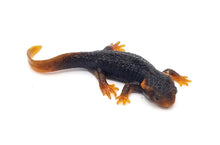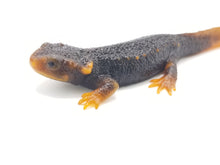
Shipping Info: When selecting the shipping option for this animal, be aware that we ship Tuesdays for Wednesday arrival. Factors such as holidays and weather conditions may delay our ability to ship the animal on the expected date.
Latin name: Tylototriton verrucosus
These captive bred crocodile newts are young adults and are about 4” in length from nose to tail tip. They are eating earthworms, live black worms and small crickets dusted with vitamin and calcium powder.
We have multiple unsexed individuals available, photos are representative of our general stock.
General info: These prehistoric looking newts are lined with two sets of knob-like lateral glands down each side of their backs. Something that sets them apart from most other newt species is that they lay their eggs on land! The larvae make their way to water once they hatch.
Range and habitat: Crocodile Newts are found in northern Burma, Darjeeling and parts of Southeast Asia. Their habitat types include forests, grasslands, swamps and marshes.
Size and lifespan: As adults, these newts usually reach about 5-6” in length and females grow a bit larger than males. Their lifespan in human care is often around 10 years with some individuals living 15+ years with optimal care.
Quick care stats:
Temperatures: 77 degrees Fahrenheit water temperature during the summer and 55-64 degrees Fahrenheit water temperature in winter. Be careful not to let them overheat which can happen if the water temperature reaches above 80 degrees.
Humidity: 60%-80% mist twice per day if keeping these guys with a large land area.
Tank size: 5 gallons for babies, 20 gallons for adults. Consider providing more space when housing these individuals communally.
Tank type: Standard rectangular aquarium.
Heating and Lighting: This species can be kept almost fully aquatic so a standard aquarium heater is required.
Though this species lives on the shady forest floor and in swamps, they are diurnal so 5.0 UVB lighting is is highly recommend for overall welfare and to establish a regular day/night cycle.
Substrate and furniture: . If housing with partial land and partial water: soil or coconut fiber substrate about 2” deep on top of hydro balls and netting or aquarium gravel. Provide lots of hiding places in the form of logs and false or live plants and a large sized water dish. Use dechlorinated water always.
If housing fully aquatic: Use gravel substrate, aquatic plants (live or false) and 5+ inches of dechlorinated water to simulate their environment. Haul-out structures like large rocks and pre-soaked driftwood should be provided for at least some land space. Use a gentle filtration system in the tank with a carbon filter.
Handling: Crocodile newts stress out easily when touched and have sensitive skin so we don’t recommend them for frequent handling. At most they should be handled only when necessary for servicing their habitat.
Diet and feeding: Small crickets, earthworms, wax worms, blood worms, black worms and snails.
both adults and babies can be offered 3-6 feeder items 3-4 times per week.
Gauge how much your newt will eat based on the food items they leave behind and their body condition.
Always remove uneaten feeder insects if they have not been consumed after a day.
*All food items must be dusted with both vitamin and calcium powder prior to feeding.*
Food size: The feeder item should simply be able to fit width wise between your newt’s eyes.

















